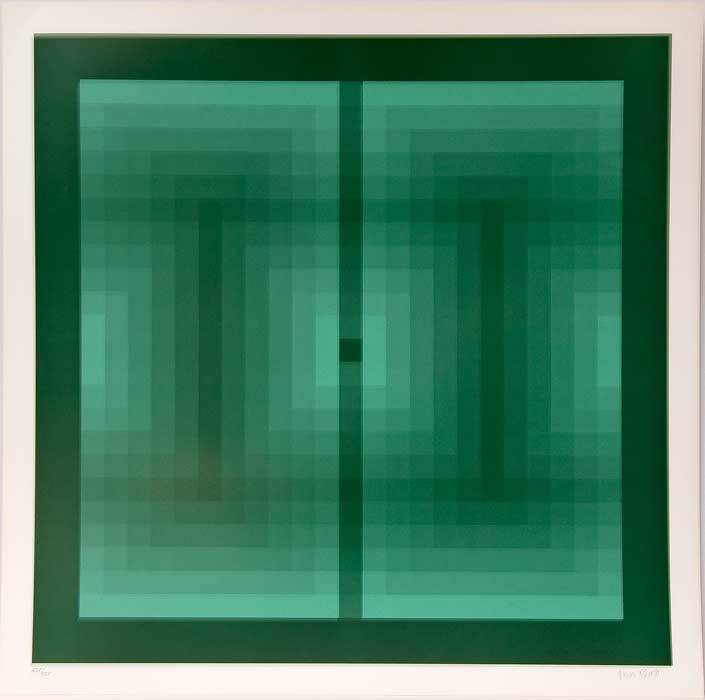Jim Bird TRIBUTE TO VASARELY, Litho 1972
TRIBUTE TO VASARELY & MORE Helga Philipp, Victor Vasarely, Jim Bird,┬ĀRudolf Kristoffer,┬Ā
Winfried Windbichler & Alexandra Gschiel.
The exhibition shows limited graphic by Helga Philipp, Victor Vasarely, Jim Bird, works on canvas by Rudolf Kristoffer and Irmfried Windbichler and a video installation by Alexandra Gschiel.
Victor Vasarely; born Gy┼æz┼æ V├Īs├Īrhelyi, Hungarian: P├®cs 9 April 1906 ┬ĀŌĆō 15 March 1997), was a Hungarian-French artist, who is widely accepted as a “grandfather” and leader ┬Āof the Op art movement and is one of its most important representatives, alongside artists like Jes├║s Rafael Soto, Yaacov Agam and Josef Albers.
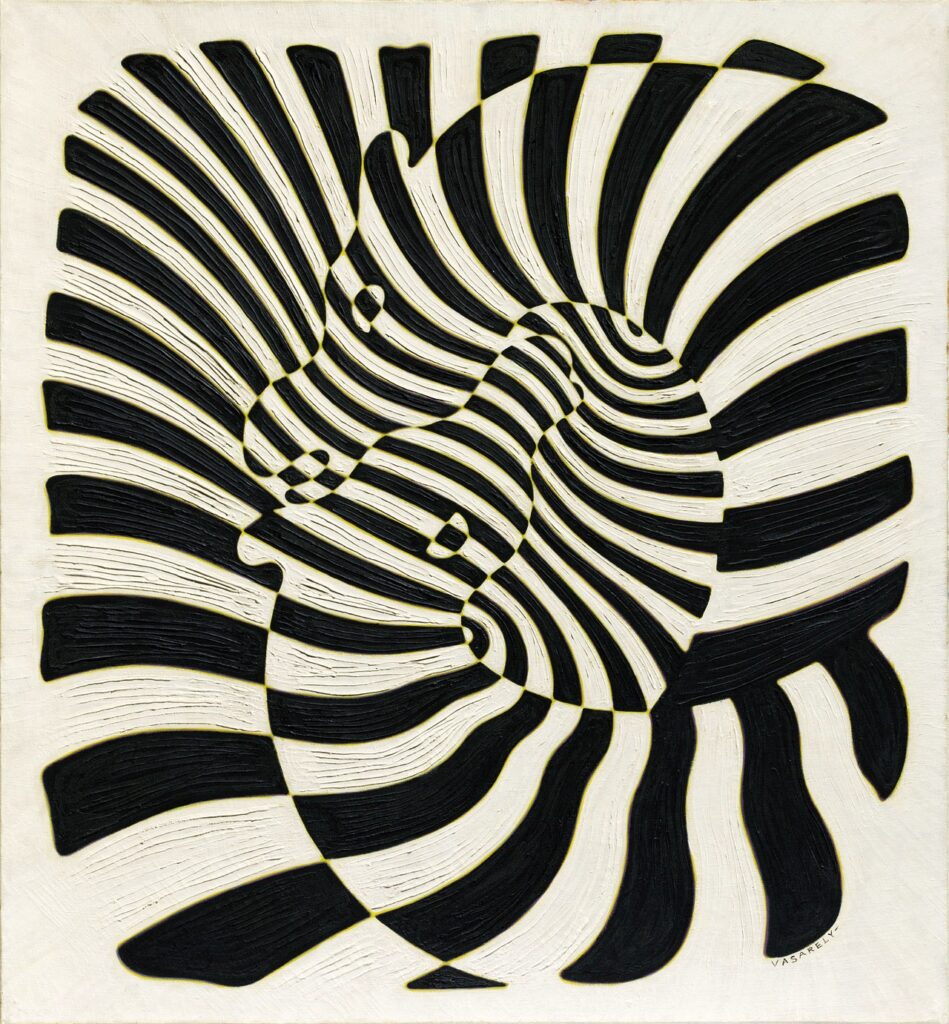
Zebra

Victor Vasarely (1906 – 1097): Folklore-Spielobjekt
His work entitled Zebra, created in the 1930s, is considered by some to be one of the earliest examples of Op art.
Vasarely started his artistic training at the Podolini-Volkmann Academy, a private school of drawing in Budapest, before S├Īndor Bortnyik introduced him to the Bauhaus concept. In his early years as an artist, the works of Josef Albers and Wassily Kandinsky had a lasting impression on him.
He moved to Paris in 1930, where he lived until his death┬Āin age 90 in Paris on 15 March 1997.
To start with, he worked as a graphic artist, produced zebra studies and carried out his initial optical experiments. He then turned away from figurative painting and developed his unmistakable style: optical image patterns paired with kinetic effects.
He married Claire Spinner in 1931, and their son Jean Pierre was born in 1934. Jean Pierre became known as an artist under the name ŌĆ£YvaralŌĆØ.
From the mid-1940s onwards, Vasarely presented his works in Paris for the first time. In the decades that followed, he showed his art around the world as part of exhibitions.
His most well-known projects include his black and white creations, the ŌĆ£plastic alphabetŌĆØ and ŌĆ£VegasŌĆØ.
His works are to be found in numerous collections held by international cultural institutions, such as ChicagoŌĆÖs Art Institute or LondonŌĆÖs Tate Gallery.
ŌĆ£Art for allŌĆØ was his motto. In the 1970s and 80s two museums dedicated to the artist were opened in Hungary – one in P├®cs and one in Zichy Castle in Budapest.
Helga Philipp (born 1939 in Vienna, died 2002 in Vienna), pioneer
of Austrian Op Art, began her studies at the University of Ap- plied Arts Vienna aged 14 and attended Hans KneslŌĆÖs Sculpture course. She taught at the Univer- sity of Applied Arts Vienna from 1965 through to 2002 as an assis- tant professor to Herbert Tasquil.

Helga Philipp, Kinetisches Objekt um 1963
Between 1962 and 1968 Philipp generated kinetic acrylic glass objects. From 1969 through to 1972 she preferred to make screen prints. Her choice of acryl- ic glass and screen printing was quite deliberate, with her artistic goals being to depersonalize art objects and to turn away from the notion of the artist-as-genius as propagated by the older gener- ation. In the mid-1980s, Philipp made paintings in black and white and grey tones. The works made in this late phase of her career were carried out in an ŌĆśautoma- tizedŌĆÖ brush stroke.
In 1965 and 1968ŌĆō9, Philipp took part in the exhibitions New Tendencies 3 and 4 in Zagreb,
as well as in Kinetika at the Muse- um of the 20th Century in Vienna in 1967. In the following year
she exhibited at Galerie n├żchst St. Stephan together with Marc Adrian and Richard Kriesche, in 1973 at the Austrian Institute in New York.
As a pioneer of Concrete Art and Op Art in post-war Austria, Helga Philipp┬Ā succeeded in fusing Kinetic Art and new Constructive tendencies. Kinetic Art originated at the ŌĆ£AngewandteŌĆØ (University of Applied Arts)1 in Vienna post-1920, where Philipp taught from 1965 onwards and where her friend Erika Patka was setting up an archive. PhilippŌĆÖs contacts with the ŌĆ£Wie- ner GruppeŌĆØ (Vienna Group) and their language art combined with her scien- tific interest in cybernetics and computer art, as well as Max BenseŌĆÖs informa- tion theory, and these strands together paved the way for her work. Helga Philipp always kept herself exceptionally well informed on developments in theory, and her personal library encompassed important international magazi- nes and catalogues, including literature on the American Minimal and Concept Art scene around John Cage and his love of Far Eastern Zen philosophy.2
EuropeŌĆÖs Concrete Art scene of the 1960s and 1970s started off as a group that adopted a rigorous, austere aesthetic which obeyed the logic and utopia of a second Enlightenment. Experimental film paved the way for the new media arts. In 1965, Kurt Kren made what was probably the most formal film of his career about PhilippŌĆÖs early screen print series (p. 202). She exhibi- ted at Galerie n├żchst St. Stephan together with Marc Adrian and Richard Kriesche as early as 1968, and co-founded the short-lived artist group A ustria with Kriesche and Jorrit Tornquist on the occasion of an exhibition in Forum Stadtpark in Graz in the same year. This meant that her committed advocacy of feminism was not geared towards the ŌĆ£female aestheticŌĆØ discussed at the time. Unlike her female colleague Kiki Kogelnik, who was also supported by Monsignore Otto Mauer and who progressed in the US from Constructivism and Abstract Expressionism to Happenings and WomenŌĆÖs Liberation from 1961 onwards, Philipp sought a completely new artistic method, namely a still current, democratic one that dissolved gender roles, through Op Art.
While still studying sculpture at the University of Applied Arts under Hans Knesl, Philipp encountered international Op Art at the Venice Bienniale in 1958 and through her friends working in experimental and formal film in Vienna, in particular, through the work of Venezuelan artist Jes├║s Rafael Soto (1923ŌĆō2005, fig. 3, p. 84).8 This rousing encounter caused her to cast aside any remnants of figurative thinking as well as of the notion of the block, as seen in the abstract sculptures of classical Modernist works of Constantin Brancusi among others, whose oeuvre her mentor Knesl had advised her to explore. She also came into contacts with poets, for example in Viennese venues such as Caf├® Hawelka, and in this way Philipp brought together the concepts of Op Art and the Concrete Poetry of the ŌĆ£Wiener GruppeŌĆØ in her series of screen prints. After seeing her Op Art boxes, H. C. Artmann called Philipp ŌĆ£one of usŌĆØ.9 This means that Artmann and his colleagues Gerhard R├╝hm and Friedrich Achleitner saw sequences, iterations and inversions in PhilippŌĆÖs works that corresponded with the ideas of Concrete Poetry. With its particular framing and cuts, KrenŌĆÖs film 11/65 Bild Helga Philipp inspired Philipp to test new methods of geometrical superimposition with optical effects.10 According to Peter Weibel, the crucial aspect to both Philipp and KrenŌĆÖs work was their exploration of optical distortion or aberration that went beyond mere cinematography. View on:┬Āhttps://monoskop.org/images/9/91/Abstract_Loop_Austria_Adrian_Kriesche_Philipp_Rockenschaub_2016.pdf
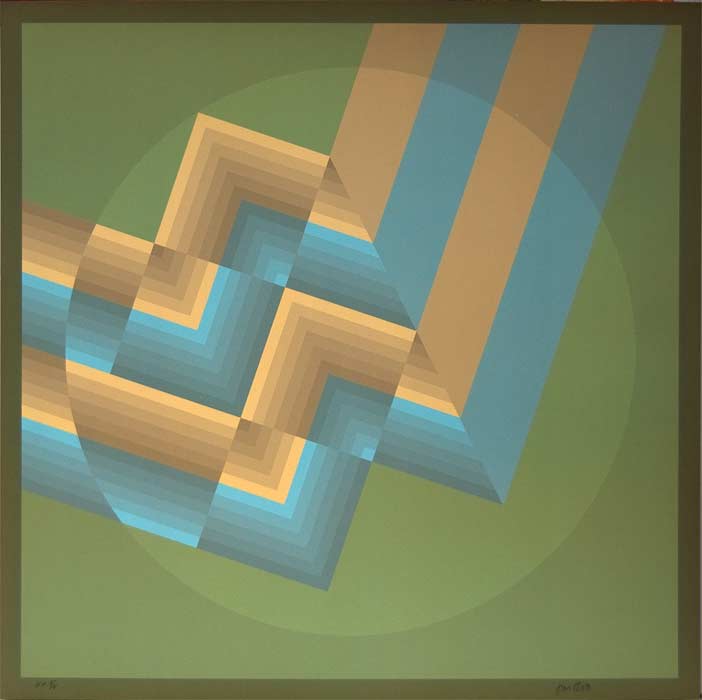
Jim Bird, Lithograph 1972
Jim Bird. Born 1937, Bloxwich, U.K. – Died 2010, Catalonia, Spain,┬Āwas a well-known abstract English painter and printmaker. ┬ĀIn 1962, Jim Bird left a successful design studio in England to live as an artist in Spain and USA, where he became a close friend of the painter Robert Motherwell, whom he admired very much, with whom he participated in several exhibitions. ┬ĀHe soon became affiliated with Galeria Joan Prats in Madrid, one of the most prestigious galleries in Spain and beyond.┬ĀJim Bird has had over 100 solo exhibitions around the world. Sustaining a tradition of gestural field abstraction, he described his work as a direct drive approach to painting.┬ĀHe creates a sequence of visual sensations comparable to the poetry of a small self-contained haiku. His works describe “Landscapes of the Mind”, he transforms them into Tributes for Vasarely.

Rudolf Kristoffer
YOU’RE THE VOICE, 2020
The young half-Swedish Rudolf Kristoffer┬Ā(born and raised in Graz, Austria), influenced by the art and culture of the sixties, his father’s stories from swinging London, his own travels there and the many concert visits, integrates his own or well-known pictures into op-like psychedelic colour patterns and geometric shapes – depending on the chosen theme, based on musical impressions.
The new work by Winfried Windbichler (*1947, Kitzb├╝hel) fits into the appeal “Art for all”. After his fence painting, which hung in the Street Gallery for two years, was stolen, the artist has left us a new one:┬ĀA poetically feathered landscape.┬ĀIn his works Irmfried Windbichler refers to changeability, in both a positive and negative sense.
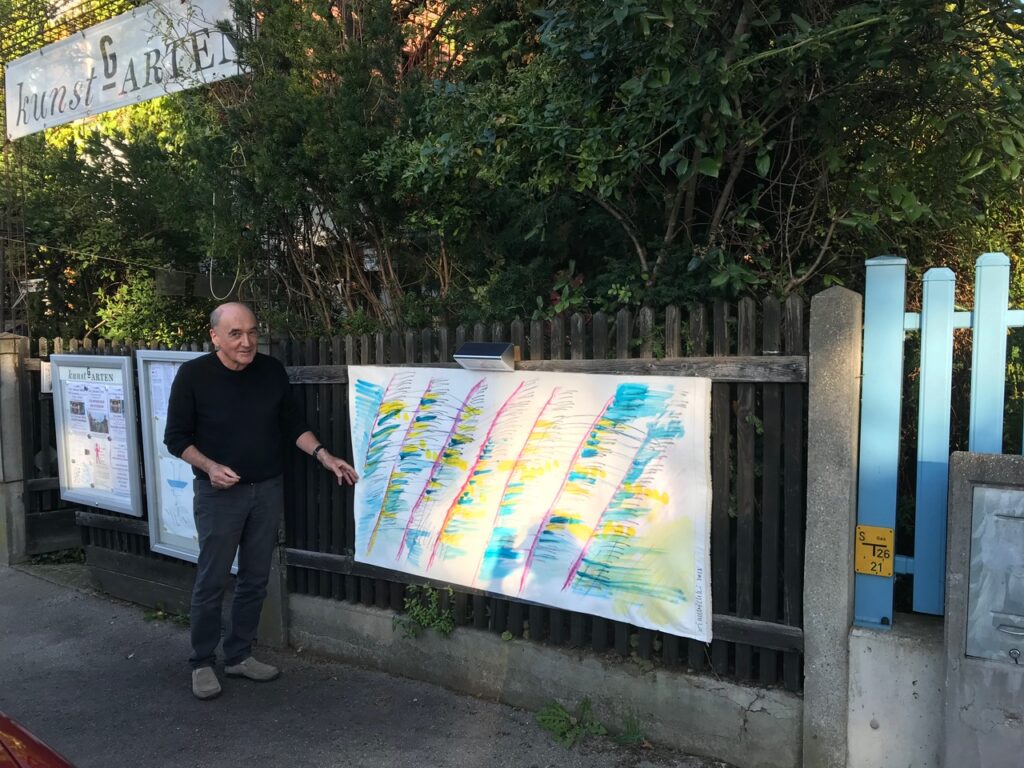
Irmfried Windbichler ZAUNBILD 2018, THE NEW ONE
When he declares the fence on the street side with his picture as an art fence, as a gallery for passers-by, he takes a stand on the understanding of art in our time. His works are based on a social and aesthetic approach. For he only wants to preserve for the future that which meets these criteria.
Alexandra Gschiel (*1974 Vorau).
The photographer lives and works in Graz. She makes photos, videos, textil art and installations.
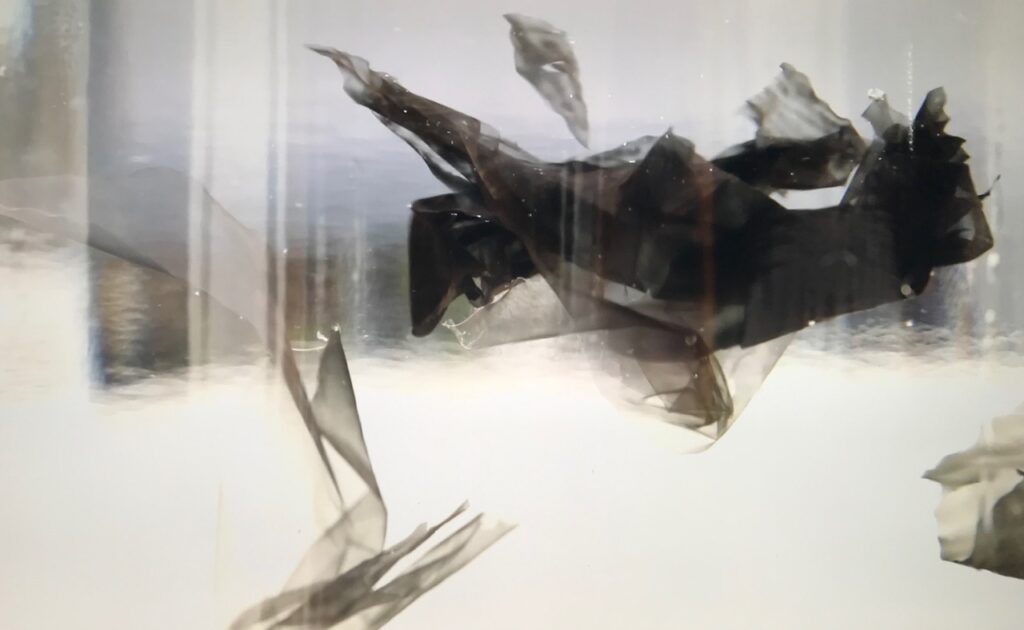
Alexandra Gschiel SILVER-GELATIN-FISH 2019, FilmStill
The aesthetic installation Silver Gelatin Fish by Alexandra Gschiel approaches the theme of deception in a completely different way and as a contrast to poetic and mathematical calculation. The video loop, a 4-minute experimental film with Silver Gelatin Fish in water, suggests the movements of rays, Ancistrus catfish or tassel fish, thus tending to stimulate the human imagination, drifting off, creating breathing space and freedom for imagination and personal imagination. Gschiel (born 1974 in Vorau) has a classical photography education and works with the media of photography, video, installation, sculpture and textiles.┬ĀSince 2009 she has a studio in the Schaumbad – Freies Atelierhaus Graz and since 2011 she is on its board.
To let contemporary art have its say means to deal with the present.
Do OP-Art paintings give us the opportunity to explore spaces, to reconstruct our perceptual illusions, the question is, are we also aware of this when we enter a temple of consumption?┬ĀWill all the glamour captivate our gaze, that we cannot perceive the destructive power of glamour? Will the advertised gold bar make us aware of the miners’ sensitivities? If suggestive images on the Internet can influence our information, how do we counteract this?
Where are the boundaries where we recognise optical illusion as fraudulent seduction?
On view until 2 May 2021.
INFORMATION
- Please make reservations not later than 2 hours before the programme begins: kunstGarten@mur.at or +43 316 262787. Covid 19 rules must be observed!

